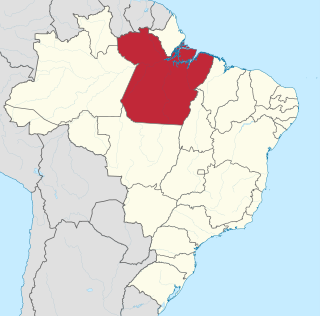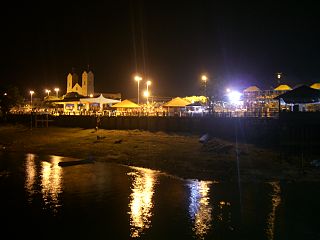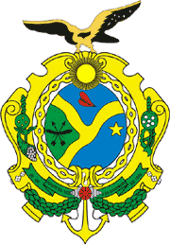
The Tocantins River is a river in Brazil, the central fluvial artery of the country. In the Tupi language, its name means "toucan's beak". It runs from south to north for about 2,450 km. It is not really a branch of the Amazon River, since its waters flow into the Atlantic Ocean alongside those of the Amazon. It flows through four Brazilian states and gives its name to one of Brazil's newest states, formed in 1988 from what was until then the northern portion of Goiás.

Amazonas is a state of Brazil, located in the North Region in the north-western corner of the country. It is the largest Brazilian state by area and the ninth-largest country subdivision in the world. It is the largest country subdivision in South America, being greater than the areas of Chile, Paraguay, and Uruguay combined. Mostly located in the Southern Hemisphere, Amazonas is the third-largest country subdivision in the Southern Hemisphere after the Australian states of Western Australia and Queensland. Located entirely in the Western Hemisphere, it is the fourth-largest country subdivision in the Western Hemisphere after Greenland, Nunavut, and Alaska. If independent, Amazonas could become the sixteenth-largest country in the world, slightly larger than Mongolia. Neighbouring states are Roraima, Pará, Mato Grosso, Rondônia, and Acre. It also borders the nations of Peru, Colombia and Venezuela. This includes the Departments of Amazonas, Vaupés and Guainía in Colombia, as well as the Amazonas state in Venezuela, and the Loreto Region in Peru.

Pará is a state of Brazil, located in northern Brazil and traversed by the lower Amazon River. It borders the Brazilian states of Amapá, Maranhão, Tocantins, Mato Grosso, Amazonas and Roraima. To the northwest are the borders of Guyana and Suriname, to the northeast of Pará is the Atlantic Ocean. The capital and largest city is Belém, which is located at the Marajó bay, near the estuary of the Amazon river. The state, which is home to 4.1% of the Brazilian population, is responsible for just 2.2% of the Brazilian GDP.

Belém often called Belém of Pará, is a Brazilian city, capital and largest city of the state of Pará in the country's north. It is the gateway to the Amazon River with a busy port, airport, and bus/coach station. Belém lies approximately 100 km upriver from the Atlantic Ocean, on the Pará River, which is part of the greater Amazon River system, separated from the larger part of the Amazon delta by Ilha de Marajó. With an estimated population of 1,499,641 people — or 2,491,052, considering its metropolitan area — it is the 11th most populous city in Brazil, as well as the 16th by economic relevance. It is the second largest in the North Region, second only to Manaus, in the state of Amazonas.

The Captaincies of Brazil were captaincies of the Portuguese Empire, administrative divisions and hereditary fiefs of Portugal in the colony of Terra de Santa Cruz, later called Brazil, on the Atlantic coast of northeastern South America. Each was granted to a single donee, a Portuguese nobleman who was given the title captain General.
A donatary captain was a Portuguese colonial official to whom the Crown granted jurisdiction, rights, and revenues over some colonial territory. The recipients of these grants were called donatários (donataries), because they had been given the grant as a doação (donation) by the king, often as a reward for service.

Itaituba is a city and municipality located in the state of Pará, Brazil, and one of the most important socioeconomic centers in the western region of the State.

This is a timeline of Amazon history, which dates back at least 11,000 years ago, when humans left indications of their presence in Caverna da Pedra Pintada.

Gurupá or Santo Antonio de Gurupá is a municipality on the Amazon River in state of Pará, northern Brazil located near the world's largest river island, Marajó, 300 km upstream from the upper mouth of the river on the Atlantic coast.

Francisco Caldeira e Castelo Branco (1566–1619) was a Portuguese explorer and colonial administrator. He is noted as the founder of the city of Belém, capital of Pará, Brazil, on 12 January 1616. Caldeira served as the first Governor General of the Captaincy of Grão-Pará.

The State of Maranhão was the northern of two 17–18th century administrative divisions of the colonial Portuguese Empire in South America.
The History of Belém refers to the history of this Brazilian municipality in the Northern Region of the country, the capital of the state of Pará, which had its origins in the 17th century in the indigenous region of Mairi, located 160 km from the equator.

Francisco Xavier de Mendonça Furtado (1701–1769) served in Portugal's armed services rising in rank from soldier to sea-captain, then became a colonial governor in Brazil and finally a secretary of state in the Portuguese government. His major achievements included the extension of Portugal's colonial settlement in South America westward along the Amazon basin and the carrying out of economic and social reforms according to policies established in Lisbon.

The Fort of Santo Antônio de Gurupá, located in the current-day city of Gurupá, was a Portuguese military fortification in the 17th and 18th centuries, being actively occupied by the Brazilian military as recently as 1958.
The Fort of Taurege, also known as Fort of Taurege River, Fort of Torrego, Fort of Tourege, Fort of Torrejo, and Fort of Maracapuru, was a colonial era Amazonian fort located in the confluence of the Taurege River and the Amazon Delta, possibly in the Island of Tucujus.

Cidade Velha, initially called Mairi, Cidade or Sé neighborhood, is a historic area of the capital of Pará, Belém, founded in the 1620s. It is the first and oldest neighborhood in the city, originated from the Portuguese colonial settlement Feliz Lusitânia and the construction of the wooden fortress Forte do Presépio, at the mouth of the Piry creek, by Portuguese Captain-Mor Francisco Caldeira Castelo Branco, on January 12, 1616. He had the goal of occupying the Conquista do Pará in the then Captaincy of Maranhão, ensuring the dominance of the region and the drogas do sertão.

Conquista do Pará, also called the Império das Amazonas, now the Brazilian state of Pará, was an indigenous territory transformed into Portuguese colonial territory in 1615 by the military man and nobleman Alexandre de Moura, at the beginning of the colonization of the Amazon and conquest of the Amazon River. It was located in the then Captaincy of Maranhão (1534-1621).

The Tupinambá Uprising (1617-1621), also called the Tupinambá Revolt, took place on January 13, 1618, and was led by the tuxaua (cacique) Cabelo de Velha, who gathered several native indigenous groups from the busy Mairi region to fight against the Portuguese, due to the abuses committed by these colonizers when they exploited the indigenous labor force in the Conquest of Pará. This movement was one of a series of uprisings that took place in the region between 1617 and 1619. The disputes culminated in the attack in January 1619 by the Tupinambá on the Presépio Fort, located on the shores of Guajará Bay.

The history of Amazonas is the result of treaties, religious missions and a few indigenous rebellions in the Amazon territory. Initially, under the Treaty of Tordesillas, the site belonged to the Spanish Kingdom, but was later annexed by the Portuguese Crown. The state's international borders, undefined after Brazil's independence in 1822, were demarcated during the signing of the Treaty of Bogotá. Archaeological research suggests past occupations by Paleo-Indian hunter-gatherer groups, dated around 11,200 years before the present day.
















